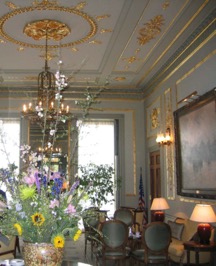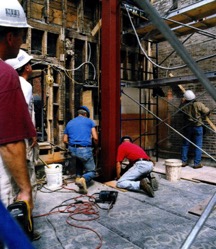Somerset Club, Multiple Capital Improvement Projects
Beacon Hill, Boston, Massachusetts

Client
Somerset Club of Boston
Phase IA
Reconstruction and Restoration of the 1871 Rear Ell building project
Value: $2 Million
Completed: 2000
Phase IB
Reconstruction and Preservation of the 1831 Sears House at 42 Beacon - Exterior façade restoration project
Value: $2.3 Million
Completed: 2001
Phase IC
Courtyard and Waterproofing Improvements
Value: $2 Million
Completed: 2002
Phase ID
Noise Mitigation and Kitchen interior and Exterior Repairs
Value: $1.5 Million
Completed: 2003
General Contractors
MF Reynolds
Shawmut Design + Construction
Consigli Construction
Architect
Robert Olson and Associates



Galanis Consulting was commissioned in 1999 to serve as the Somerset Club’s owner's representative for a variety of projects and provided the Project Management services for their Capital Improvement Program. The permitting process consisted of working with the Beacon Hill Historic Commission, and City of Boston Inspectional Services during the design. Galanis Consulting past experiences in the complete restorations and renovations at the Alexander Parris designed structures of 39 and 40 Beacon Street allowed us to share similar permitting, structural and architectural design issues with the Somerset Club project team.
The Somerset Club Building Committee recognized the pivotal role of this Alexander Parris designed historical landmark in its mission and makes its preservation an integral component in decisions implementing that mission. The Building Committee understands the delicate balance between multiple objectives that are common today as institutions, like the Somerset Club, work to preserve historically significant structures in the context of changing physical needs and limited resources.
Galanis Consulting worked with the Somerset Club’s Building Committee, and Robert Olson & Associates in recording, restoration, and reconstruction at this complex of buildings, which has evolved since William Sears built a house in 1822 on a site previously owned by John Singleton Copley. In 1806, Harrison Gray Otis began to develop nearby parcels. Alexander Parris (1780-1852) designed Sears's original house and its expansion in 1831. Both Sears and Otis expanded their holdings on adjacent sites in 1831. Sears reconfigured his building again in 1837 by creating a grand symmetrical frontage, moving its entrance to the main façade, and adding a third story. At that point, it was probably the most expensive dwelling in Boston. The construction of the third story matches the horizontal extension, therefore, RO&A believed that it was added in the 1831 (or 1831 to 1837) expansion. In 1871, the Somerset Club acquired the Sears house and constructed, or expanded, renovated and raised, the rear ell where the main dining room is located. The second floor billiards room, once connected to bowling lanes above the main level kitchen, was destroyed in a 1945 fire.
The project team consciously exploited the seams where separate periods of construction came together to introduce new vertical circulation; introduce and distribute utilities; and extend building systems up through the non-repetitive floor plans. Previously the building had offered little accessibility for disabled members; a new elevator replaced a redundant service stair and small service elevator to erase that limitation. There were horizontal interventions, most notably in the basement where excavation provided space to stack utilities runs above and below an improved service corridor. The service circulation is especially significant, where kitchen is separated from dining levels and where large functions are frequent events. The Club backs onto a street where trucks are not allowed.
The mansard roof over the rear building had spread, and its instability was serious enough to require rebuilding with a new steel frame. The original 19th-century interior had been removed in a renovation in 1949 to convert the billiards room to a cluster of dormitory rooms. The 19th-century interior was recreated based on details surviving in the attic. Sheldon Austin created new lightweight plaster saucer domes with ornamental lay light openings, segmental ribbed ceiling sections and ornamental brackets The lay lights themselves were recreated with thin steel sections housed in a wood lattice detailed to create the appearance of the original construction. An elegant curving wooden staircase also needed remedial attention from the structural engineers, to reintroduce rigidity throughout its impressive height. Stair manuals and carpentry handbooks did not explain how these complex stairs were built; they combined cantilevers and a kind of corbelling action up the curving string.
The granite facades were carefully surveyed for damage caused by the iron cramps embedded after 1821. These anchorage devices ruined the granite elevation from the roof down to the bottom of the third floor. Phoenix Bay State Masonry removed the stone, took out the iron and replaced the upper façade with the reused ashlar and some matching granite from new sources: the replacement granite was Mason granite. The cornice was heavily deteriorated and had to be entirely replaced. In addition to the corrosion-jacking, feldspar in the granite had eroded, and there was extensive sugaring and scaling. Marble cartouches in the façade were carved by Solomon Willard.
The project was constructed in four phases over the ten years. The most recent project, the interior renovation and restoration, required the Somerset Club to close its doors for ten months. Multiple general contractors were contracted with depending upon their specialty of work. MF Reynolds was used for the exterior façade and roof restorations and rear ell reconstruction; Shawmut Design + Construction was used for the interior courtyard reconstruction and utilities, as well as kitchen renovations; Consigli Construction was used for the front gate restoration; and Richard White & Sons was used for the interior project. Total cost of the Capital Improvement Program was approximately $23 million.